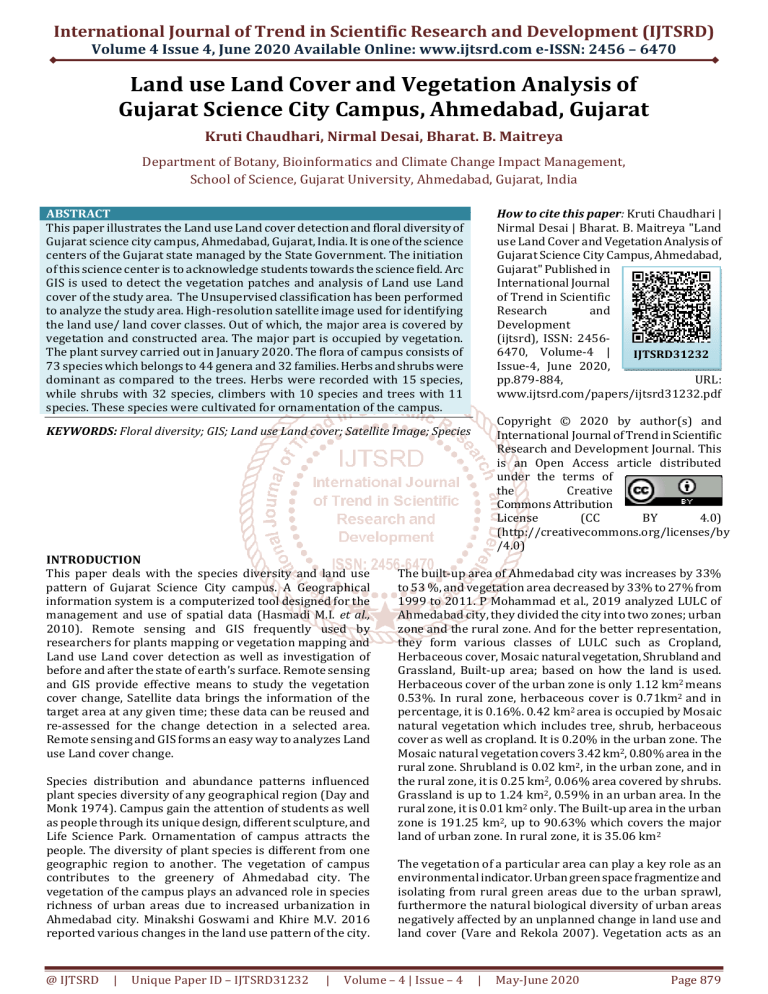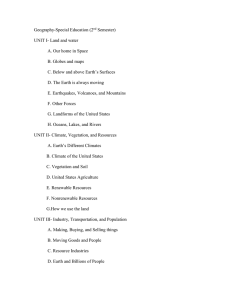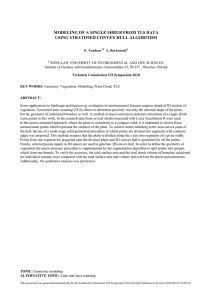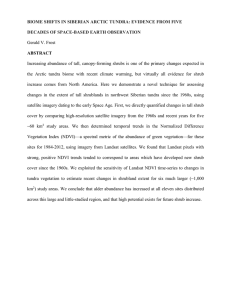
International Journal of Trend in Scientific Research and Development (IJTSRD)
Volume 4 Issue 4, June 2020 Available Online: www.ijtsrd.com e-ISSN: 2456 – 6470
Land use Land Cover and Vegetation Analysis of
Gujarat Science City Campus, Ahmedabad, Gujarat
Kruti Chaudhari, Nirmal Desai, Bharat. B. Maitreya
Department of Botany, Bioinformatics and Climate Change Impact Management,
School of Science, Gujarat University, Ahmedabad, Gujarat, India
How to cite this paper: Kruti Chaudhari |
Nirmal Desai | Bharat. B. Maitreya "Land
use Land Cover and Vegetation Analysis of
Gujarat Science City Campus, Ahmedabad,
Gujarat" Published in
International Journal
of Trend in Scientific
Research
and
Development
(ijtsrd), ISSN: 24566470, Volume-4 |
IJTSRD31232
Issue-4, June 2020,
pp.879-884,
URL:
www.ijtsrd.com/papers/ijtsrd31232.pdf
ABSTRACT
This paper illustrates the Land use Land cover detection and floral diversity of
Gujarat science city campus, Ahmedabad, Gujarat, India. It is one of the science
centers of the Gujarat state managed by the State Government. The initiation
of this science center is to acknowledge students towards the science field. Arc
GIS is used to detect the vegetation patches and analysis of Land use Land
cover of the study area. The Unsupervised classification has been performed
to analyze the study area. High-resolution satellite image used for identifying
the land use/ land cover classes. Out of which, the major area is covered by
vegetation and constructed area. The major part is occupied by vegetation.
The plant survey carried out in January 2020. The flora of campus consists of
73 species which belongs to 44 genera and 32 families. Herbs and shrubs were
dominant as compared to the trees. Herbs were recorded with 15 species,
while shrubs with 32 species, climbers with 10 species and trees with 11
species. These species were cultivated for ornamentation of the campus.
Copyright © 2020 by author(s) and
International Journal of Trend in Scientific
Research and Development Journal. This
is an Open Access article distributed
under the terms of
the
Creative
Commons Attribution
License
(CC
BY
4.0)
(http://creativecommons.org/licenses/by
/4.0)
KEYWORDS: Floral diversity; GIS; Land use Land cover; Satellite Image; Species
INTRODUCTION
This paper deals with the species diversity and land use
pattern of Gujarat Science City campus. A Geographical
information system is a computerized tool designed for the
management and use of spatial data (Hasmadi M.I. et al.,
2010). Remote sensing and GIS frequently used by
researchers for plants mapping or vegetation mapping and
Land use Land cover detection as well as investigation of
before and after the state of earth’s surface. Remote sensing
and GIS provide effective means to study the vegetation
cover change, Satellite data brings the information of the
target area at any given time; these data can be reused and
re-assessed for the change detection in a selected area.
Remote sensing and GIS forms an easy way to analyzes Land
use Land cover change.
Species distribution and abundance patterns influenced
plant species diversity of any geographical region (Day and
Monk 1974). Campus gain the attention of students as well
as people through its unique design, different sculpture, and
Life Science Park. Ornamentation of campus attracts the
people. The diversity of plant species is different from one
geographic region to another. The vegetation of campus
contributes to the greenery of Ahmedabad city. The
vegetation of the campus plays an advanced role in species
richness of urban areas due to increased urbanization in
Ahmedabad city. Minakshi Goswami and Khire M.V. 2016
reported various changes in the land use pattern of the city.
@ IJTSRD
|
Unique Paper ID – IJTSRD31232
|
The built-up area of Ahmedabad city was increases by 33%
to 53 %, and vegetation area decreased by 33% to 27% from
1999 to 2011. P Mohammad et al., 2019 analyzed LULC of
Ahmedabad city, they divided the city into two zones; urban
zone and the rural zone. And for the better representation,
they form various classes of LULC such as Cropland,
Herbaceous cover, Mosaic natural vegetation, Shrubland and
Grassland, Built-up area; based on how the land is used.
Herbaceous cover of the urban zone is only 1.12 km2 means
0.53%. In rural zone, herbaceous cover is 0.71km2 and in
percentage, it is 0.16%. 0.42 km2 area is occupied by Mosaic
natural vegetation which includes tree, shrub, herbaceous
cover as well as cropland. It is 0.20% in the urban zone. The
Mosaic natural vegetation covers 3.42 km2, 0.80% area in the
rural zone. Shrubland is 0.02 km2, in the urban zone, and in
the rural zone, it is 0.25 km2, 0.06% area covered by shrubs.
Grassland is up to 1.24 km2, 0.59% in an urban area. In the
rural zone, it is 0.01 km2 only. The Built-up area in the urban
zone is 191.25 km2, up to 90.63% which covers the major
land of urban zone. In rural zone, it is 35.06 km2
The vegetation of a particular area can play a key role as an
environmental indicator. Urban green space fragmentize and
isolating from rural green areas due to the urban sprawl,
furthermore the natural biological diversity of urban areas
negatively affected by an unplanned change in land use and
land cover (Vare and Rekola 2007). Vegetation acts as an
Volume – 4 | Issue – 4
|
May-June 2020
Page 879
International Journal of Trend in Scientific Research and Development (IJTSRD) @ www.ijtsrd.com eISSN: 2456-6470
acoustic screen between noise- sources and receivers but
also prevent noise by generating pleasant sounds. This
positive impact play role of benefits to humans mental and
physical health as well as children’s growth and their
educational results (Gonzalez- oreja JA et al., 2010, Nijland
HA et al., 2003, Kaplan R, 2001, Taylor AF 2002, Van
Renterghen T et al., 2012) Urban greenery decorates natural
or artificial scenery, it helps human to reduced stress by
providing pleasant visual quality. An investigation reveals
that green views increased the capacity of recovery of an ill
person (Ulrich RS 1984, Van den Berg AE et al., 2010) and
also increased concentration ability. Emili Redon et, al., 2020
explore the “bigLeaf” approach of the interaction soilBiosphere-Atmosphere (ISBA) model deals with energy
exchange between atmosphere and vegetation, they
reported that the canopy trees and mass of vegetation can
reduce the temperature and maintain the- the town energy
balance. Urban greenery or vegetation not only makes
human comfort but also provides economic benefits via
decreasing energy and health care costs. Natural vegetation
is difficult to maintain in the era of globalization due to
urban sprawl. Cultivated gardens and green areas are
bringing the taxonomic richness and increase the greenery
of Ahmedabad city.
Objectives
1. To detect vegetation patches through remote sensing.
2. To quantification of Land use Land cover of study area
through iso cluster unsupervised classification.
3. To list out the plants of the study area by ground survey.
Material and Method
Study area
The Gujarat Science City is a government’s initiative to
educate students in the science field. The campus situated
between 23.0800⸰ N and 72.4936⸰ E. Study area is approx.
6.495 km2. Half of the area is without any infrastructure due
to the reason campus is maximum covered by vegetation. In
the future, it is expected that there would be a change on
campus. It is the most visited place in Ahmedabad city. The
campus is designed by proper planning and management.
Science City has cultivated plants, ornamental plants, and as
well as it has a broad area of natural vegetation and common
plants which are seen in Ahmedabad so in this place we can
observe all types of plants and its habitats. The Science city is
far away from central Ahmedabad, it is situated near Sardar
Patel ring road, which can consider as the boundary of the
city. The study aims to estimate, both natural and planned
(by humans) state of the earth’s surface. This science center
has both sites, planned as well as a natural state of the land
surface. Due to this reason this site was chosen.
|
Unique Paper ID – IJTSRD31232
Figure 3: Location of Gujarat science city
LULC (Land use Land cover) classification through
Remote sensing and GIS techniques
1. Satellite image of the study area with high resolution
was taken for January 2020 from Google earth pro.
2. The Image was georeferenced by using QGIS 3.4.11.
3. Isocluster unsupervised classification was carried out
using ArcGIS 10.4 for Land use Land cover analysis and
Scales and apt legends were used to generate Land use
Land cover map.
4. For the removal of software-based error, it was checked
with a ground survey.
Field survey
The Field survey was carried out in January 2020 for the
formulation of a plant checklist. The survey was carried out
around the campus the study area is around 6.495 km2. The
Plant checklist included plants that are inside the campus.
For the better understanding plants were noted down with
its common name, habits such as a tree, herb, or shrub. The
photographs of plants were taken for identification with
leaves, bark, and flower parts (if available). With the
comparison of Filed note information of plant species were
used as basic data for plant identification. Plant
identification was done with the help of taxonomic experts of
the university and institutions, and with the help of
literature (Cooke, A.T. 1903, 1985, Shah, 1978) available in
the library of the Botany Department, Gujarat University,
The Serenity Library, Ahmedabad.
Result and Discussion
Image analysis
Remote sensing and GIS are appropriate techniques for the
determination of land use land cover change on the earth’s
surface. Satellite data has been used for the identification of
Figure 1: Map of India
@ IJTSRD
Figure 2: satellite image of Ahmedabad city and study
area
|
Volume – 4 | Issue – 4
|
May-June 2020
Page 880
International Journal of Trend in Scientific Research and Development (IJTSRD) @ www.ijtsrd.com eISSN: 2456-6470
global land use land change since 1972 due to its constant
availability of images (Hansen and Loveland 2012). This
image represents the Iso cluster unsupervised classification.
This image illustrates different land-use patterns of the
study area. Different colors in the image represent different
classes such as open area represents by blue colour, green
color shows vegetation area, olive green represents the
constructed area and land covered with lawn highlighted by
sky blue color. Vegetation covers include small herbs, shrubs
as well as trees, cultivated plants (garden plants) also some
natural plants. The Constructed area consists of various
buildings, roads, and different parks of science center such
as life science park, dinosaur park, butterfly park, aquatic
gallery, earth dome. Study area classified into four classes:
the open area, the vegetation area, the constructed area, and
lawn area (land covered with lawn). Unsupervised
classification is self-organization data analyses, this method
of classification dose not require the primary knowledge of
land cover type before classification (J.B campbela et al.,
2011, R.O. et al., duda 2009). This method was proceeded by
forming maximum clusters. The software identified the pixel
itself and generated the cluster, similar clusters form one
group. In this image, the land without vegetation and
construction considered as open area.
Land use Land cover analysis
Graph 1 represents land-use patterns of the study area in
percentage. This graph concludes four classes which are
calculated in percentage, the open area is 18% represented
by blue color. The vegetation area is in red up to 52%, the
constructed area shown by green color is 27% and the lawn
area represented by purple colour is about 3%. Maximum
area covered by vegetation and minimum area covered by a
lawn of gardens. The information of Land use land cover
patterns will help in the future for the formulation and
further development of the campus.
Graph 1: Represents Land use Land cover in parentage
Plant list
The List of surveyed plant species of campus indicated a
total of 73 species including herb, shrub, grass, climber,
sedges, and tree belongs to 44 genera and 32 families
Figure 4: unsupervised classification of study area
Table 1: List of plants, Local name (Gujarati), Families, Habit.
Botanical name
Family
Habit
Agave Americana
Agavaceae
Shrub
Agave capensis gentry
Agavaceae
Shrub
Agave joe hoak
Asparagaceae
Shrub
Agave sisalana perrive
Agavaceae
Shrub
Agave angustifolia var. angustifolia
Asparagaceae
Shrub
Agave desmettiana Jacobi
Asparagaceae
Shrub
Agave victoriae reginae T. Moore
Asparagaceae
Shrub
Agave xylonacantha sal m- Dyck
Asparagaceae
Shrub
Agenolaema marantifolia Blume
Araceae
Herb
Agenolaema simplex Blume
Araceae
Herb
Allamanda blanchetii A DC
Apocynaceae
Shrub
Allamanda cathartica L.
Apocynaceae
Shrub
Allopteropsis cimicina (L.) Stapf
Poaceae
Grass
Alluaudia procera (Drake) Drake
Didiereaceae
Shrub
Aloe barbadense Mill
Liliaceae
Herb
Aloe vera (L.) Burm.f.
Asparagaceae
Herb
Aloe perryi Baker
Asparagaceae
Shrub
Aloe aristata Haw.
Xanthorrhoeaceae
Herb
Alysicarpus spp
Fabaceae
Herb
Aralia chinensis L
Araliaceae
Shrub
@ IJTSRD
|
Unique Paper ID – IJTSRD31232
|
Volume – 4 | Issue – 4
|
May-June 2020
Page 881
International Journal of Trend in Scientific Research and Development (IJTSRD) @ www.ijtsrd.com eISSN: 2456-6470
Aralia racemosa L
Aralia fruticosa Sesse & Moc.
Araucaria columnaris (Forsk.) Hook
Bahunia acuminata L.
Bauhinia tomentosa L
Caladium bicolor (Aiton) Vent
Caladium esculentum Vent
Caladium hertulanum Bridsey
Cannabis sativa L.
Carallum crenulata wall.
Cardiospermum halicacabum L.
Careya arborea Roxb.
Cassia grandis L
Cassia javanica L
Cassia roxburghii DC
Cereus jamacaru DC.
Cissus quadrangularis L
Desmodium gangeticum (L) DC
Desmodium scorpiurus (Sw.)Desv.
Dioscoriea alata L
Elytrophorous spicatus (Wild.)A. Camus
Eriocaulon eleanorae Fyson
Ficus elastica Roxb. Ex Honem
Fimbristylis spp
Jacaranda mimosifolia D. Don
Mallotus philippensis (Lam.)Mull. Arg.
Mammilaria longimam ma DC.
Murdania nudiflora L
Operculina turpethum(L.)Silva Manso
Opuntia elatior Mill
Opuntia ficus
Opuntia cylindrical (Lam.)DC.
Opuntia falcate Ekman & Werderm.
Opuntia Microdasys (Leh m.)Pfeiff
Opuntia tunicate (Lehm.)Pfeiff.
Oryza rufipogon Griff
Pachypodium spp
Pachypodium lamerei Dr ake
Panacratium triflorum Roxb
Pandanaus odorifera (Forssk.) Kuntze
Passifloria foetida L
Pennisetum spp
Pentas lanceolata(Forssk.)Deflers
Pentatropis capensis(L.f.)Bullock
Pergularia daemia (Forssk)Chiov
Phyllanthus virgatus G.Forst.
Piper longum L
Piper betle L.
Platycladus orienalis (L.)Franco
Yucca aloifolia L inn
Yucca pineahele
Yucca silverae
Zornia gibbosa Span.
@ IJTSRD
|
Unique Paper ID – IJTSRD31232
|
Araliaceae
Araliaceae
Araucariaceae
Caesalpiniaceae
Caesalpiniaceae
Araceae
Araceae
Araceae
Cannabaceae
Asclepiadaceae
Sapindaceae
Lecythidaceae
Caesalpiniaceae
Caesalpiniaceae
Caesalpiniaceae
Cactaceae
Vitacea
Fabaceae
Fabaceae
Dioscorieaceae
Poaceae
Eriocaulaceae
Moraceae
Cyperaceae
Bignoniaceae
Eurphorbiaceae
Cactaceae
Commelinaceae
Convolvulaceae
Cactaceae
Cactaceae
Cactaceae
Cactaceae
Cactaceae
Cactaceae
Poaceae
Apocynaceae
Apocynacea
Amaryllidaceae
Pandanaceae
Passifloraceae
Poaceae
Rubiaceae
Asclepiadaceae
Asclepiadaceae
Euphorbiceaes
Piperaceae
Piperaceae
Cupressaceae
Agavaceae
Asparagaceae
Asparagaceae
Fabaceae
Volume – 4 | Issue – 4
|
Shrub
Shrub
Tree
Tree
Tree
Herb
Herb
Herb
Herb
Shrub
Climber
Tree
Tree
Tree
Tree
Shrub
Climber
Shrub
Climber
Climber
Grass
Herb
Tree
Sedge
Tree
Tree
Shrub
Herb
Climber
Shrub
Shrub
Shrub
Shrub
Shrub
Shrub
Grass
Shrub
Shrub
Herb
Shrub
Climber
Grass
Shrub
Climber
Climber
Herb
Climber
Climber
Tree
Shrub
Shrub
Shrub
Herb
May-June 2020
Page 882
International Journal of Trend in Scientific Research and Development (IJTSRD) @ www.ijtsrd.com eISSN: 2456-6470
sinks and decreasing co2 emission by proper Management
and planning of land use (Jo. et al., 2001). Pollinators and
wild pollinators receive essential resources such as habitat
for nesting and food (flower with nectar and pollen) from
urban vegetation (Holland et al., 2016).
Graph analysis of species
Graph 2: Species in percentage
Graph 3: Species in number
Graph 2 represents the species in percentage. 44% are
shrubs, 21 % herbs, 15% trees, 14% are climbers and
only 6 % are grasses.
Graph 3 represents species in numbers with families,
Asparagaceae with 9 species, Cactaceae 8,
Caesalpiniaceae 5, Araceae 5, Apoecynaceae 4, Poaceae
4, and Fabaceae 4. These families are dominant.
The major plants are cultivated on this campus as compared
to natural plants. This is the state’s most visited science
center. Plants are cultivated for ornamentation of campus.
Due to this reason, herbs and shrubs are more dominant as
compared to trees. Herbs and shrubs are variously used for
the beautification of the campus. Vegetation contributes in
the removal of air pollutants from the atmosphere via dry
deposition and by influencing the smog (O3) process for the
improvement of air quality (Bolund, P et al., 1999, Akbari et
al., 2001, konopacki et al., 2000, Nowak et al., 1998, Thrones
J 2010). the area of leaf surface directly linked with air
temperature and air quality, urban trees and other plants of
the urban area helps to improve it via reducing air
temperature and reduced energy demands for buildings
(Akbari et al., 2001) and act as environment filter due to its
absorbing capacity of gaseous pollutants on the area of leaf
surface (Nowak et al,. 1998). The vegetation of urban regions
can impact on carbon dioxide sequestration and climate
change mitigation. The municipality can increase carbon
@ IJTSRD
|
Unique Paper ID – IJTSRD31232
|
CONCLUSION
Drastic use of land and uncontrolled urban growth resulted
in a threat to the vegetation of the particular area. It
produces destruction of the environment, geological
resources, and biological resources. This impact can be
examined by using geospatial applications; remote sensing
(RS) and geographical information system (GIS). Plants,
animals, and insects of urban areas depend on urban habitat
for food and shelter, food, especially insects and birds. Urban
vegetation captures and filters the PM pollutants from the
atmosphere and decreased the disperation of PM pollutants
from air (Chen He et al., 2020) additionally trees with large
crown with mass of branches and leaves able to decreases
the turbulent kinetic energy downwind of trees. Urban
vegetation also decreases the NO2 by absorbing it, it is also
explored that concentration pf pollutants are lower under
trees canopies as compare to in open area (Setala et al.,
2013). Urban vegetation habitat can provide condition like
natural habitat (Gilbert 1989), which is beneficial for urban
biodiversity conservation. It provides shade which can
buffer solar radiation, maintain the temperature and
moisture during the day as well as block the heat flow during
the night. The development and conservation of urban
greenery or vegetation, natural and cultivated both are
necessary. It is appropriate for human health and also
economically beneficial. Ahmedabad city is the rapidly
growing city of Gujarat state. Urban sprawl is the major
threat to species diversity Particularly in Ahmedabad city.
The Strategic process of urban and infrastructure
development requires the selection of suitable sites, new
approaches, planning, operations, networks, and urban
project management. Gardens, parks, institutional campuses
are the sources of the greenery in Ahmedabad city. It is a
primary need to maintain and develop them.
REFERENCES
[1] Hasmadi, M. I., Zaki, M. H, Adnan, I. A., Pakhriazad, H. Z.,
& Fadlli, M. A., “Determining and mapping of vegetation
using GIS and phytosociological approach in Mount
Tahan, Malaysia”, Journal of Agricultural Science, 2(2),
80, 2010.
[2] Day, F. P., Jr and C. D. Monk , “Vegetation patterns on a
southern Appalachian watershed”, Ecology 55: 10641074, 1974.
[3] Goswami, M., & Khire, M. V, “Land use and land cover
change detection for urban sprawl analysis of
Ahmedabad city using multitemporal landsat data”, Int
J Adv Remote Sens GIS, 5, 1670-1677, 2016.
[4] Mohammad, P., Goswami, A., & Bonafoni, S, “The Impact
of the Land Cover Dynamics on Surface Urban Heat
Island Variations in Semi-Arid Cities: A Case Study in
Ahmedabad City, India, Using Multi-Sensor/Source
Data” Sensors, 19(17), 3701, 2019.
[5] Väre, S., & Rekola, L., Laajat yhtenäiset metsäalueet
ekologisen
verkoston
osana
Uudellamaalla. Uudenmaan liiton julkaisuja E, 87, 53,
2007.
Volume – 4 | Issue – 4
|
May-June 2020
Page 883
International Journal of Trend in Scientific Research and Development (IJTSRD) @ www.ijtsrd.com eISSN: 2456-6470
[6] González-Oreja, J. A., BOnAChE-REGiDOR, C., & de la
Fuente-Díaz, A. A, “Far from the noisy world? Modelling
the relationships between park size, tree cover and
noise levels in urban green spaces of the city of Puebla,
Mexico”, Interciencia, 35(7), 486-492, 2010.
[7] Nijland, H. A., Van Kempen, E. E. M. M., Van Wee, G. P., &
Jabben, J, “Costs and benefits of noise abatement
measures”, Transport policy, 10(2), 131-140, 2003.
[8] Kaplan, R, “The nature of the view from home:
Psychological
benefits”, Environment
and
behavior, 33(4), 507-542, 2001.
[9] Taylor, A. F., Kuo, F. E., & Sullivan, W. C., Coping with
ADD: “The surprising connection to green play
settings”, Environment and behavior, 33(1), 54-77,
2001.
[10] Van Renterghem, T., Hornikx, M., Forssen, J., &
Botteldooren, D, “The potential of building envelope
greening to achieve quietness”,Building and
Environment, 61, 34-44, 2013.
[11] Ulrich, R, "View through a window may influence
recovery”, Science, 224(4647), 224-225, 1984.
[12] Van den Berg, A. E., Maas, J, “Verheij, R. A., &
Groenewegen, P. P, Green space as a buffer between
stressful life events and health”, Social science &
medicine, 70(8), 1203-1210, 2010.
[13] Redon, E., Lemonsu, A., & Masson, V, “An urban trees
parameterization for modeling microclimatic variables
and thermal comfort conditions at street level with the
Town Energy Balance model (TEB-SURFEX
v8.0)”, Geoscientific Model Development, 13(2), 385399, 2020.
[14] Cooke, A.T 1903, 1958. The Flora of the president of
Bombay, Vol. I-III, Botanical survey of India, Calcutta.
[15] Shah, G.L. 1978. Flora of Gujarat State.
[16] Prajapati, B.K. (2018). Checklist of floweing plants of
Ahmedabad district. M.Sc. Thesis, Gujarat university,
Ahmedabad.
[17] Raghavan, R. S., Wadhwa, B. M., Ansari, M. Y., & Rao, R.
S. (1981). checklist of the plants of Gujarat. RecordsBotanical Survey of India.
[18] Sudhira, H. S., Ramachandra, T. V., and Jagadish, K. S,
“Urban sprawl: metrics, dynamics and modelling using
GIS,” International Journal of Applied Earth
Observation and Geoinformation, 5(1), 29-39, 2004.
@ IJTSRD
|
Unique Paper ID – IJTSRD31232
|
[19] Hansen, M. C., and Loveland, T. R, “A review of large
area monitoring of land cover change using Landsat
data,” Remote sensing of Environment, 122, 66-74,
2012.
[20] Bolund, P. (1999). Hunhammar, s. Ecosystem services in
urban areas. Ecological Economics, 29, 293-301.
[21] Akbari, H., & Taha, H, “The impact of trees and white
surfaces on residential heating and cooling energy use
in four Canadian cities”, Energy, 17(2), 141-149, 1992.
[22] Konopacki, S., & Akbari, H, “Energy savings calculations
for heat island reduction strategies in Baton Rouge”,
Sacramento and Salt Lake City, 2000.
[23] Nowak, D. J., McHale, P. J., Ibarra, M., Crane, D., Stevens,
J. C., & Luley, C. J, “Modeling the effects of urban
vegetation on air pollution” In Air pollution modeling
and its application XII (pp. 399-407). Springer, Boston,
MA, 1998.
[24] Jo, H. K., & McPherson, E. G, “Indirect carbon reduction
by residential vegetation and planting strategies in
Chicago”,
USA. Journal
of
Environmental
Management, 61(2), 165-177, 2001.
[25] Holland, J. M., Bianchi, F. J., Entling, M. H., Moonen, A. C.,
Smith, B. M., & Jeanneret, P, “Structure, function and
management of semi-natural habitats for conservation
biological control: a review of European studies”, Pest
management science, 72(9), 1638-1651, 2016.
[26] J.B. Campbell, and R.H. Wynne, “Introduction to Remote
Sensing”, Guilford Press: New York, NY, USA, 2011; Vol.
5.
[27]
R.O. Duda, P.E. Hart, and D.G. Stork, “Pattern
Classification and Scene Analysis Part 1: Pattern
Classification”; Wiley: Chichester, UK, 2000.
[28] He, C., Qiu, K., Alahmad, A., & Pott, R, “Particulate
matter capturing capacity of roadside evergreen
vegetation during the winter season” Urban Forestry &
Urban Greening, 48, 126510, 2020.
[29] Setälä, H., Viippola, V., Rantalainen, A. L., Pennanen, A.,
& Yli-Pelkonen, V, “Does urban vegetation mitigate air
pollution in northern conditions?”, Environmental
Pollution, 183, 104-112, 2013.
[30] Gillbert, O. L,”The ecology of urban habitats–Chapman
& Hall”, London/New York, 1-369, 1989.
Volume – 4 | Issue – 4
|
May-June 2020
Page 884






